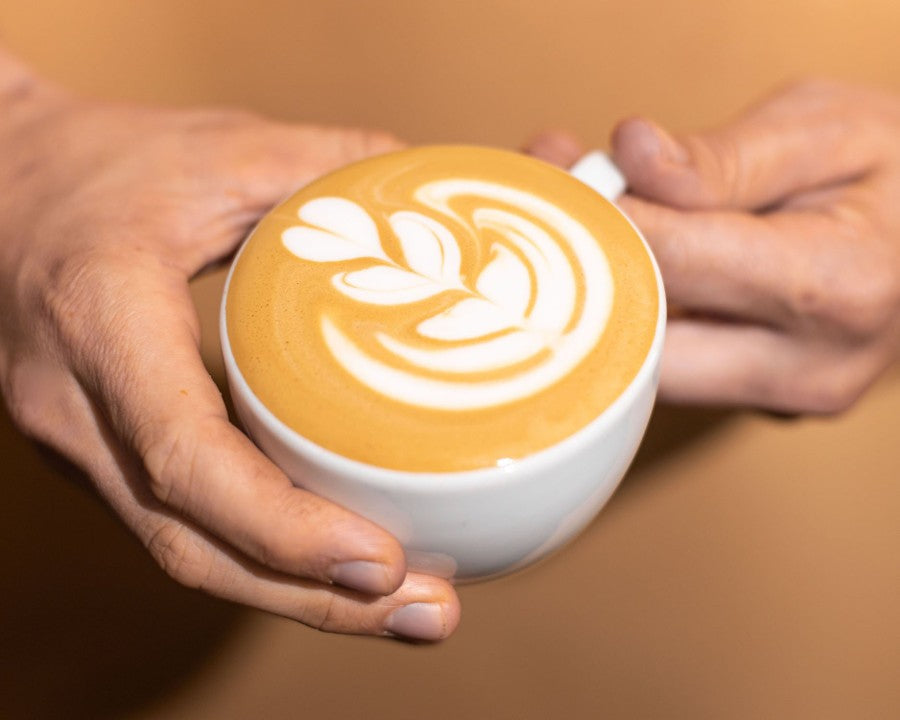Latte art is everywhere, from high-end specialty cafés to your morning scroll on social media. A heart, a tulip, a graceful swan—these intricate designs are not just decoration. They represent the craftsmanship, care, and technical skill behind a cup of coffee.
Latte art isn’t only about what you see. It is a sign of quality espresso, well-steamed milk, and the barista’s ability to combine those elements intentionally. This article explores the latte art, where it came from, how it works, and how one can improve their pour.
What is latte art?
Latte art is the pattern or design you typically see on the surface of drinks like lattes, cappuccinos, and similar milk-and-espresso-based drinks. It is created by pouring steamed milk into a shot of espresso to form a visible design on the surface. Latte art relies on two key components: crema and micro foam. The espresso’s crema (rich, reddish-brown foam) is the canvas. The milk must be textured into microfoam, with fine, velvety, and pourable bubbles that are shiny and pourable.
During the pour, the barista starts high to allow the milk to sink under the crema, then lowers the pitcher to let the foam rise and create a pattern. Timing, speed, and angle all determine the outcome. This technique is built on repetition and sensitivity to touch and flow.

Photo: CC
A brief history of Latte Art
While the combination of milk and espresso dates back to Italy, modern latte art didn’t emerge until the late 1980s in Seattle. David Schomer, founder of Espresso Vivace, is credited with pioneering the practice. His engineering background led him to experiment with milk texture and crema manipulation. He eventually developed the heart design and documented the technique in his book Espresso Coffee: Professional Techniques.
Latte art became a signature feature of third-wave coffee culture by the early 2000s and spread globally. Competitions like the World Latte Art Championship, launched in 2005, showcase baristas’ creativity and elevate the profession.
The science behind the pour
Latte art is possible because of milk chemistry and fluid dynamics. Steamed milk contains proteins, mainly casein, that stretch and stabilize air bubbles. This creates microfoam, typically dense, smooth, and shiny.
Temperature is critical. Milk should be steamed between 55–65°C (130–149°F). If it's too hot, the proteins scald; if it's too cold, the foam collapses. During steaming, baristas first stretch the milk by adding air, then spin it to emulsify the foam and heat it evenly. The finished milk should resemble wet paint, such that it is thick enough to sit on top of the crema, but fluid enough to pour.
The espresso crema also plays a role. It must be stable and well-extracted, offering resistance and contrast for the milk to ‘draw’ on. Without good crema, the design simply won’t appear.
These principles are supported by research from the Specialty Coffee Association and published studies in food science, including the Journal of Food Engineering.
Common Latte Art designs
The three most common latte art patterns are the heart, the rosetta, and the tulip.

Photo: a heart, rosseta, and tulip, clockwise from left.
The heart is the simplest design. To make it, pour steadily, lower the pitcher near the surface, and give a gentle push to form a round shape. Finish by cutting through to create the pointed base.
Rosetta resembles a fern or leaf. This design uses a gentle side-to-side wiggle while pouring, followed by a central cut to pull the leaves into form.
The tulip is made by stacking layers of foam. Each push creates a new “blob,” and a final cut through the stack completes the tulip shape.
Advanced designs include the swan (a combination of a rosetta, tulip, and curved neck), and free pour illustrations like bears, flowers, or even portraits. Some baristas use etching tools to draw details, although free-pour art is considered more technically pure in competitions.

How to improve your latte art
Begin with the right tools: a steam-capable espresso machine, a pointed-spout milk pitcher, and cups with a rounded base to help the milk flow. For best results, use fresh, cold whole milk. Plant-based milks, especially barista-formulated oat milk, can also work.
During steaming, incorporate air in the first few seconds, then spin the milk to achieve a glossy texture. Let the milk rest for a moment before swirling it gently to integrate the foam.
When pouring, begin high and slow to integrate the milk with the espresso. As the cup fills, lower the pitcher to let the foam rise and begin your design. Focus on control and consistency rather than complexity.
Practice the same cup size repeatedly, and don’t be afraid to pour badly—those "mistake cups" teach you more than perfect ones.
Why latte art matters
Beyond the visual flair, Latte art is a marker of quality and intention. A well-poured design signals that the espresso was pulled properly, the milk was steamed with care, and the barista took time to craft something beautiful.
It also connects people. Latte art is a form of hospitality; one that invites conversation, appreciation, and creativity. In coffee competitions and community throwdowns, it becomes a shared language of skill and expression.
While the extra touch often makes the drink memorable for customers, it’s a quiet form of pride for baristas. For both, it is a small reminder that the ordinary can be meaningful.
Final thoughts
Latte art is fleeting, but the craft behind it is lasting. Embrace the process if you are just starting. You’ll make plenty of abstract blobs before you ever pour a clean heart. That’s part of the fun.
In a fast-paced world, taking the time to make something beautiful, even in foam, is a powerful act. So, steam the milk, pick up the pitcher, and pour. You are not just making coffee. You are creating a moment.
Further resources
Espresso Coffee: Professional Techniques by David Schomer
Specialty Coffee Association – Milk Science & Barista Skills
World Latte Art Championship


Comments